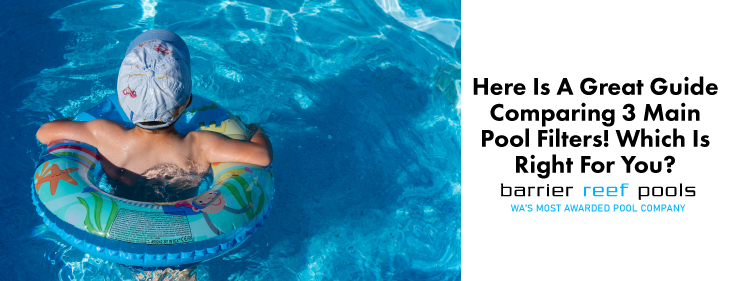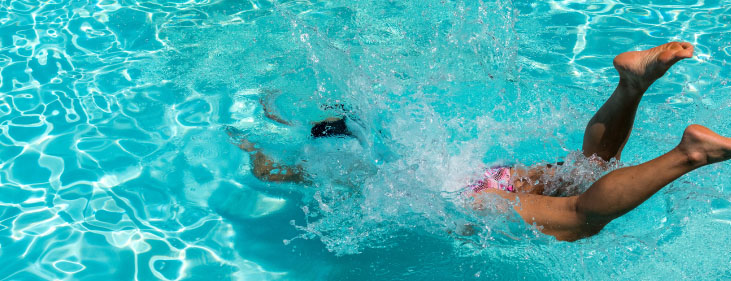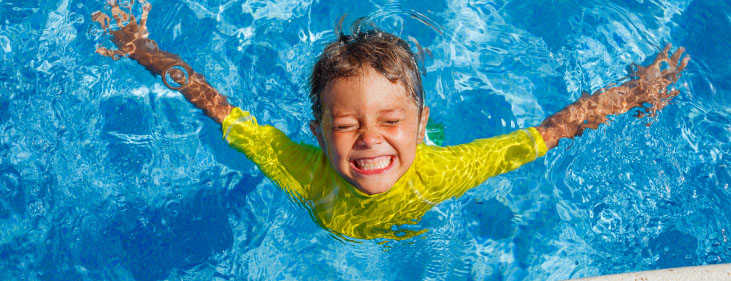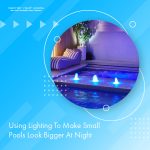No pool set-up is complete without a filter. They collect all the nasty contaminants from the water to create a safe and healthy swimming environment. While all filters have the same objective – to keep the water clear, they don't all work the same. We've put together this post to share the key differences with the three most common types of pool filters to help you decide which one is right for you.

Let’s take a look!
Sand filters
The name may give it away but sand filters contain sand. The pool water is pumped through this, collecting any impurities along the way. The cleansed water then returns back to the pool. This process is continuous.
Sand filters are very popular due to their hassle-free maintenance and economical cost. They can pick up particles as small as 20 microns. To give you an idea of how small that is, a strand of hair is around 50 microns, so it can pick up microscopic fragments.
Check out our post on getting rid of sand at the bottom of your pool!
Looking after a sand filter
For your sand filter to be able to work at its best, you need to ensure that you are keeping up with regular maintenance. Don’t worry, this isn’t a laborious task, they just need a little TLC here and there. A telltale sign that your sand filter needs cleaning out is a raised PSI reading on the gauge. Backwashing the system will rectify this in most cases. This flushes out any nasties that have accumulated in the filter.
How often do sand filters need to be replaced?
Sand filters will typically last 3 to 5 years when regular backwashing is done.
Different sand filters
There are a couple of different types of sand filters you can have for your pool, including:
Zeolite sand filter
Zeolite sand filters contain volcanic rock sand, and this effectively collects chloramines in the water to produce a higher level of water quality.
Silica sand filter
The sand in silica sand filters is made from crushed quartz, and this type is the most economical of the three and is great at collecting small particles from the water.
Glass sand filter
The sand in the filter is made using recycled glass and is capable of clearing algae from the water.
Advantages to sand filters
The filters aren’t overly expensive
Easy maintenance
Three different sand filters to choose from
Replacements are only required every 3 to 5 years
Disadvantages to sand filters
- Some particles smaller than 20 microns, may not be picked up when using an entry-level sand filter.
- More water is typically used due to backwashing frequently.
- Can use more energy if used with a high-pressure pool system.

Cartridge Filters
Cartridge filters are stowed in a large plastic tank, and anything from one to four filters is used. They are a hollow tube covered in a cloth material that can be folded or pleated depending on the type you choose.
Pool water is pumped to the filter, and it passes through the cartridges as it goes. The cloth-like material collects dirt or nanoscopic particles in the process. This clean water is sent back to the pool and this continues until the pool pump is switched off.
Looking after a cartridge filter
Looking after your cartridge filters is easy. You simply remove them from the housing tank and give them a good rinse off with a hose. Once you’ve cleaned all the filters, they can go back into the tank.
How often do cartridge filters need to be replaced?
Much like sand filters, cartridge filters last for around 3 to 5 years.
Advantages to cartridge filters
Simple to look after
Great energy efficiency
Superior filtrating capabilities
Use less water
Disadvantages to cartridge filters
- The cartridges are more expensive
- The cleaning requires a more manual hands-on effort
- Maintenance is slightly more time consuming

Diatomaceous Earth (DE) Filters
Diatomaceous filters are powder-coated fabric grids that live in a plastic tank. DE powder covers the fabric grids to increase the level of filtration offered. They can collect the smallest nanoscopic particles of all the filter options.
Pool water is pumped through the filter and through the DE powder fabric grids where it collects impurities.
Looking after a DE filter?
DE filters, while offering exceptional filtering potential, are the most tedious to look after. They need backwashing, and the DE powder needs to be replenished each time after you do this. DE powder can be replaced by adding it to the skimmer while the pump is on. To remove any stuck in debris in the filter you should hose them out along with backwashing.
How often do DE filters need to be replaced?
When looked after as per your user manual, you can expect your DE filters to last around 7 to 10 years.
Replacing your DE filter can be done by:
- Turning the pump off
- Letting out air from the pressure valve
- Opening up the tank
- Removing the old DE filters
- Replacing with new DE filters
- Closing the tank
- Turning your pump on again
- Replenishing the DE powder via the skimmer
Advantages to DE filters
- They have nearly double the lifespan of the other two filters
- DE filters pick up the most contaminants from the water to give you the most superior cleaning potential
Disadvantages to DE filters
- The system is the most expensive
- They use more water than cartridge filters
- DE powder can be hazardous, so it needs to be handled and stored properly
- The maintenance is more laborious
- The ongoing costs are higher

Picking the right filtration system for your swimming pool
Everyone has different priorities when it comes to pool care. Some want less maintenance, whereas others don’t mind the extra maintenance if it means saving money or achieving a higher level of water quality.
Here’s our post on pool cleaners!
All three options that we’ve mentioned in this post work exceptionally well, and with regular maintenance, you can expect them to keep your pool water nice and clean. We hope that this post has given you an idea on which type may be best suited to you.
If you have any questions on this topic or you are looking into installing a fibreglass pool, contact the professionals here at Barrier Reef Pools Perth! We manufacture, fit and install stunning fibreglass pools and we’d love to be of assistance if we can.



